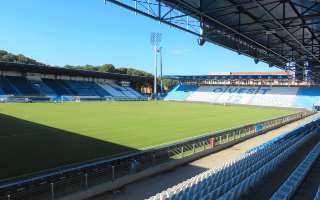Stadio Comunale Paolo Mazza
| Capacity | 16 134 |
|---|---|
| Country | Italy |
| City | Ferrara |
| Clubs | SPAL |
| Inauguration | 20/09/1928 (SPAL - Modena) |
| Renovations | 1951, 2018 |
| Cost | $ 14 million |
| Design | HI-TECH PROJECT S. R. L. |
| Address | Corso Piave, 28, 44121 Ferrara, Italia |
Advertisement
Stadio Paolo Mazza – stadium description
The fourth oldest existing stadium across Italy, built back in 1928, stands in the strict centre of Ferrara. Its initial layout included both a running track and velodrome but with the development of football meant changes had to come. In 1951 capacity grew exponentially.
Eventually a full 'rectangular' stadium was created, with the southern main stand upgraded several times, the west end expanded and covered between 1960s and 1988. At the latter date its cantilever roof was among exemplary structures of its kind in Italy. From 1982 the stadium is named after Paolo Mazza, former president of SPAL.
But the beginning of 21st century was very painful both for SPAL and the stadium. The team went bankrupt, while the stadium saw the east stand being razed, beyond saving. North side proved too deteriorated to allow full use as well. Even the cantilever above 1988 was under-maintained. By 2015 the capacity had to be reduced to just some 5,000 for safety reasons.
After a couple failed attempts at full revival, changed finally came with the Colombarini family arriving at the club as new investors, dreaming of participation in Serie A. Along with investment in the club, from 2016 onwards the club has also provided new turnstiles, wider field, renovation of players' facilities and gradual improvements in other areas. Former east stand was replaced by a temporary tubular structure to raise capacity.
In 2017, after 49 years of absence, SPAL won promotion to Serie A. While temporary infrastructural exemption was possible, major work needed to come soon. It happened almost at once, in 2018. Together with the municipality of Ferrara, the Colombarini family invested €8 million (3 and 5m each) to deliver a very satisfying outcome.
The main southern stand saw further renovation, the opposite north side was thoroughly revamped and received its first ever roof. West end saw partial roof replacement and expansion to finally cover all of the field's width. And finally, a brand new east stand was delivered. While it's a simple steel structure, it's still entirely covered and has sufficient infrastructure to last years. In its entirety, the stadium looks almost brand new, while respecting historical elements. It's also considered a very 'British' stadium, even if that's a necessity with existing spatial constraints.
Advertisement
Pictures

27.09.2018 © PascalMondragon (cc: by-sa) 
02.10.2018 © Lungoleno 
02.10.2018 © Lungoleno 
02.10.2018 © Lungoleno 
02.10.2018 © Lungoleno 
02.10.2018 © Lungoleno 
06.01.2018 © MM Groundhopping 
06.01.2018 © MM Groundhopping 
06.01.2018 © MM Groundhopping

 StadiumDB
StadiumDB



